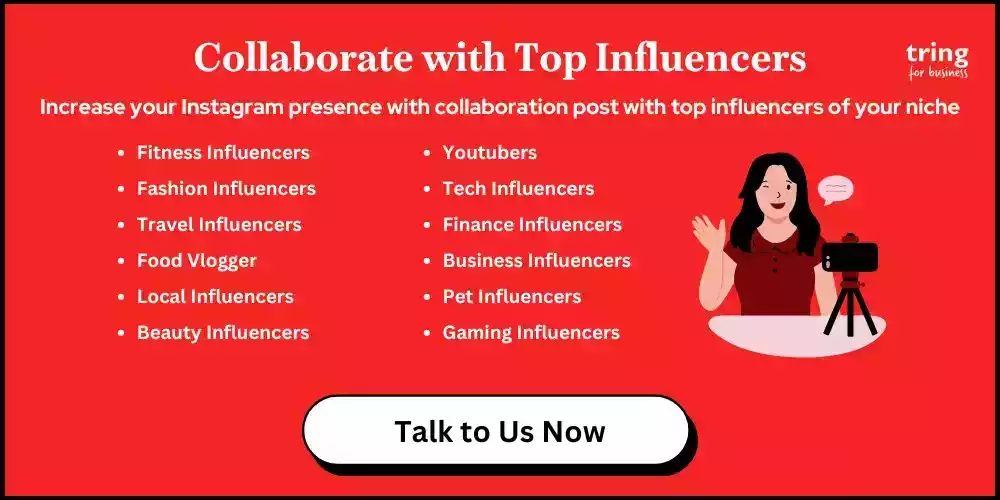Benefits of Using Micro-Influencers
1. High Engagement Rates
One of the standout benefits of micro-influencers is their remarkable engagement rates. Unlike macro influencers, who may have millions of followers but lower interaction rates, micro-influencers typically maintain a smaller yet highly engaged audience. Studies have shown that micro influencers can achieve engagement rates of 4% to 8%, compared to just 1% to 3% for larger influencers.
This means that their followers are not only seeing the content but actively liking, commenting, and sharing it. For brands, this increased engagement translates into greater visibility and a higher likelihood of conversion. When potential customers see real interactions and feedback on a product, they are more inclined to trust and try it themselves. In essence, micro-influencers create a vibrant online community where followers feel more connected to the influencer and, by extension, the brand.
2. Authentic Connections
Micro-influencers often cultivate authentic relationships with their followers. Unlike celebrities who may seem distant or unattainable, micro-influencers are perceived as relatable peers. Their followers see them as friends or trusted sources of information rather than mere promoters. This authenticity fosters a strong sense of kinship, making followers more receptive to recommendations.
When a micro-influencer shares their experiences or endorses a product, it feels personal. This word-of-mouth marketing can be far more impactful than traditional advertising methods. Consumers are increasingly skeptical of overt advertisements; they seek genuine recommendations. As a result, endorsements from micro-influencers can lead to higher conversion rates and foster brand loyalty among their audience.
3. Cost-Effectiveness
Engaging micro-influencers is generally more budget-friendly compared to collaborating with high-profile celebrities. While celebrity endorsements can come with hefty price tags, micro-influencers often charge significantly less for their services. This cost-effectiveness allows brands to stretch their marketing budgets further and run multiple campaigns across various micro-influencers.
By working with several micro-influencers instead of one macro influencer, brands can reach a broader and more diverse audience. This strategy not only maximizes exposure but also enables brands to tap into different segments of their target market. The cost savings can be redirected towards other aspects of the marketing campaign, such as content creation or product development, ensuring a well-rounded approach.
4. Niche Targeting
Micro-influencers often have expertise or a strong following in specific niches, whether it’s vegan cooking, fitness, fashion, or tech gadgets. This specialization allows brands to effectively target their desired audience. Instead of a one-size-fits-all approach, brands can partner with micro-influencers whose followers align closely with their ideal customer profile.
For businesses with niche products or services, this targeted approach is particularly beneficial. For instance, a brand that sells eco-friendly kitchenware can collaborate with micro-influencers focused on sustainable living, reaching consumers who are already interested in environmentally conscious products. This strategy not only enhances the likelihood of conversions but also helps establish the brand as a trusted name within a specific community.
Collaborate With The Best Influencers! Contact Us!
![Collaborate with Multiple Influencers Collaborate with Multiple Influencers]()
Developing a Micro-Influencer Marketing Strategy
Creating an effective micro-influencer marketing strategy involves a series of thoughtful steps. By carefully considering each aspect, brands can maximize the impact of their campaigns. Here’s a more detailed look at the key components involved in developing a successful strategy:
1. Identifying Your Target Audience
Before diving into the selection of influencers, it’s essential to have a clear understanding of your target audience. This involves developing detailed buyer personas, which are fictional representations of your ideal customers. Consider various factors to create these personas, such as:
- Demographics: Age, gender, location, income level, and education.
- Interests: Hobbies, lifestyle choices, and values. What do they enjoy doing in their free time? What causes are they passionate about?
- Behaviors: Online habits, preferred social media platforms, and shopping patterns. How do they consume content? Do they prefer videos, blogs, or social media posts?
Knowing your audience inside and out will help you identify influencers whose followers match these personas. This alignment ensures that your message resonates and that you reach the right people with your campaign. It also allows for better content customization, enhancing the overall effectiveness of your marketing efforts.
2. Setting Clear Campaign Goals
Next, establish clear and measurable goals for your micro-influencer marketing campaign. Defining what you want to achieve will help guide your strategy and provide benchmarks for success. Common campaign goals include:
- Increasing Brand Awareness: If you want to make more people aware of your brand, focus on influencers with a wide reach. This can involve tactics like brand mentions, product placements, and storytelling.
- Driving Website Traffic: If your goal is to bring more visitors to your website, consider influencers who can create engaging content that encourages their followers to click through to your site.
- Generating Leads: If you’re aiming to gather leads for your business, you might ask influencers to promote a free trial, newsletter sign-up, or exclusive offer that requires followers to provide their contact information.
- Boosting Sales: For direct sales goals, collaborating with influencers to create promotional posts, discount codes, or limited-time offers can encourage followers to make purchases.
Having clear objectives allows you to tailor your content and approach accordingly. It also helps you measure the success of your campaign against these predefined goals, providing valuable insights for future efforts.
3. Choosing the Right Micro Influencers
Selecting the right micro-influencers is a critical step in your strategy. Here are key factors to consider when evaluating potential influencers:
- Niche: Choose influencers who operate in areas relevant to your brand. For example, if you sell health products, look for fitness enthusiasts or wellness advocates who share similar values.
- Audience Demographics: Ensure the influencer’s audience aligns with your target buyer personas. Review their follower demographics, including age, gender, location, and interests, to ensure compatibility.
- Engagement Rates: Look beyond follower counts. Higher engagement rates, such as likes, comments, and shares, indicate that the influencer’s audience is actively engaged with their content. This engagement is a good indicator of the influencer's ability to drive interactions with your brand.
- Content Style: Review the influencer's past content to ensure their style and messaging align with your brand's image. An influencer whose tone, aesthetics, and values resonate with your brand will be more credible and effective in promoting your products.
4. Finding and Engaging Micro-Influencers
Discovering and engaging with the right micro-influencers can be done through various methods:
- Tools and Platforms: Utilize platforms like Instagram, TikTok, and influencer marketing tools such as AspireIQ, Upfluence, or BuzzSumo to find micro influencers within your niche. These platforms often provide analytics that can help you evaluate potential influencers' reach and engagement levels.
- Reaching Out: Once you've identified potential influencers, reach out with a personalized message. Show genuine interest in their content and explain why you believe they would be a great fit for your brand. Be clear about your goals and what you hope to achieve through the collaboration.
- Building Relationships: Don’t just focus on one-off collaborations. Aim to build long-term relationships with micro-influencers. Regular communication and collaboration can lead to more authentic endorsements and a deeper connection between the influencer and your brand.
5. Creating Compelling Campaigns
Once you've partnered with micro-influencers, it's essential to focus on creating engaging and effective content:
- Types of Content: Collaborate on various formats, such as Instagram stories, blog posts, YouTube videos, or TikTok challenges. Allow influencers to showcase your products in ways that feel authentic to their style. For example, instead of a generic product review, they might share a day-in-the-life vlog that features your product in use.
- Collaborating on Creative Ideas: Give influencers the freedom to contribute their creative input. When they have a say in the content creation process, the resulting posts feel more genuine and resonate better with their audience. Encourage them to share personal stories or experiences related to your products.
- Using Hashtags and Challenges: Incorporate specific hashtags related to your campaign to track engagement and reach. You could also create challenges that encourage their followers to participate, generating even more visibility and engagement.
6. Measuring Success
To understand the effectiveness of your micro-influencer campaigns, consider these key metrics:
- Key Performance Indicators (KPIs): Track various KPIs, including engagement rates, website traffic, conversion rates, and social media growth. These metrics will help you gauge how well your campaign is performing.
- Analyzing Results: After your campaign ends, take time to analyze the results. Look at which influencers drove the most engagement and conversions. What types of content performed best? Use these insights to refine future strategies and improve your influencer marketing efforts.
- Feedback and Adjustments: Gather feedback from your influencers and their audiences to understand what resonated. Make adjustments to your future campaigns based on this feedback, ensuring continuous improvement in your approach.
Successful Micro-Influencer Campaigns
Micro-influencer campaigns have become a popular strategy for brands looking to connect with niche audiences. Unlike big-name influencers, micro-influencers often have smaller but highly engaged followings, making them effective for promoting products. By learning from both bad influencer marketing examples and top brands using influencer marketing, companies can design successful micro-influencer campaigns that resonate with their target audience. In this article, we'll highlight some standout campaigns and what made them work.
- Glossier: The beauty brand Glossier utilized micro-influencers to promote their products on social media, focusing on relatable content and authentic user experiences. By fostering a community of brand advocates, Glossier successfully created a loyal customer base and increased brand awareness.
- Fitness Brands: Many fitness companies have partnered with micro influencers who specialize in health and wellness. For example, brands like Gymshark collaborate with fitness enthusiasts who share workout tips and success stories, leading to authentic testimonials that drive sales and encourage engagement.
- Food Brands: Brands like HelloFresh have also embraced micro-influencer marketing, collaborating with food bloggers and home cooks to showcase meal kits. By sharing real-life cooking experiences and recipes, these influencers help potential customers visualize the product in their everyday lives.
![Influencer marketing Influencer marketing]()
Get The Perfect Influencer To Promote Your Brand!
Contact us to connect with the perfect influencer who aligns with your brand. Collaborate with influencers who reflect your brand’s values and resonate with your target audience. This partnership will help you expand your reach, engage with customers, and boost your sales. Contact us today to enhance your promotional strategy with the right influencer!
![button_talk-to-us]()
![birthday occasion]() Birthday Gifts
Birthday Gifts
![anniversary occasion]() Anniversary Gifts
Anniversary Gifts
![women]() Women
Women
![men]() Men
Men
![Couples]() Couples
Couples
![Couples]() Wedding Gifts
Wedding Gifts

 Birthday Gifts
Birthday Gifts
 Women
Women
 Men
Men
 Anniversary Gifts
Anniversary Gifts
 Wedding Gifts
Wedding Gifts



 We now support international payments
We now support international payments
